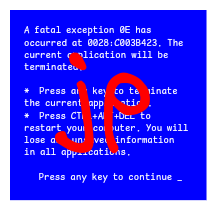- cross-posted to:
- programmerhumor@lemmy.ml
- cross-posted to:
- programmerhumor@lemmy.ml
This meme is way more clever than it should be
Took me a minute
Can you please explain? I’ve never used Mac and it’s been a long time since I’ve properly used windows.
The lightsaber orientation is the same as the slash orientation
Ha, neat!
File paths in Linux and Mac use / while Windows uses \
Take a look at the angle of the lightsabers.
I never would’ve gotten that!
Like I said, way more clever than it should be. Props to the creator for sure.
Technically, Windows understands both / and \. I personally always use / just because it’s easier to type that.
Didn’t realize until I read your comment. Thanks.
Why fight when you can just do
cd /mnt/c/Program\ Files\ \(x86\)/also applies to unix vs dos
I don’t really watch Star Wars. I’m a more of a Trekkie gal.
🖖
See, you can separate files both ways as long as it’s logical
You can actually use / as a path separator on Windows in functions like fopen(), because it supports some ancient version of POSIX standard.
The one thing about NT was that it didn’t have it’s own semantics, but it could emulate any system you wanted. It’s the unofficial successor of an OS that was based on creating VMs where you could run any other OS you want.
Then Microsoft decided to create their own system in it, and only really finished writing that one.
The big reveal comes when you realise the paths are in fact, relative.
I don’t get it
The lightsaber direction is like / \
A whole fight in characters:
/ \
X
| |
\ /- /
X
- /
I hate that I need to use escape characters when creating something for windows.
Python raw strings to the rescue!
Nobody is stopping you from using forward slashes. Python will translate the path for the current platform.
Python doesn’t have to. Windows supports both out of the box. Has been for many, many years
\o/
Ohhhhh… I fucking hate this. I use Windows locally, but I do support for a render farm that runs on Linux. The number of times I have recieved “it works locally” tickets from an artist who decided to get clever and embed Windows paths in string literals in their scene makes me want to punch a puppy. They don’t even look at the application logs we provide to see that the paths threw errors. We handle repointing their file paths with symlinks normally, but when they use literals it literally fucks the system with escapes. I will never understand why Microsoft refuses to standardize to POSIX with the rest of the world. Aside from them being a US company with decision makers who still think freedom units make sense.
Duel of the fates:
\//\Both works fine in Windows tho?
Used to not
Times change. You used to not be able to run Linux in Windows, but you can do that too.
Yeah, and I’ve tried that. It turns out it works even better if you throw away the Windows part.
Would it be more efficient to say Unix vs Windows?
Posix
I thougt linux is no longer Posix compliant, or is just partially posix compliant.
It was never fully compliant. POSIX threads, in particular, are a long time sticking point on Linux.
Is there any OS that’s fully POSIX-compliant?
Yes, in fact, there’s a formal certification process by the IEEE and the Open Group.
https://en.wikipedia.org/wiki/POSIX#POSIX-oriented_operating_systems
Mind you, I think only one of the fully-certified OSen has any substantial use these days (MacOS X). People tend to overvalue it, IMO.
I’d just like to interject for a moment. What you’re refering to as Linux, is in fact, GNU/Linux, or as I’ve recently taken to calling it, GNU plus Linux. Linux is not an operating system unto itself, but rather another free component of a fully functioning GNU system made useful by the GNU corelibs, shell utilities and vital system components comprising a full OS as defined by POSIX.
Many computer users run a modified version of the GNU system every day, without realizing it. Through a peculiar turn of events, the version of GNU which is widely used today is often called Linux, and many of its users are not aware that it is basically the GNU system, developed by the GNU Project.
There really is a Linux, and these people are using it, but it is just a part of the system they use. Linux is the kernel: the program in the system that allocates the machine’s resources to the other programs that you run. The kernel is an essential part of an operating system, but useless by itself; it can only function in the context of a complete operating system. Linux is normally used in combination with the GNU operating system: the whole system is basically GNU with Linux added, or GNU/Linux. All the so-called Linux distributions are really distributions of GNU/Linux!
There are several linux systems that don’t use GNU. Android for one. Alpine (everyone’s favorite docker image) for two. ChromeOS for three.
No, Richard, it’s ‘Linux’, not ‘GNU/Linux’. The most important contributions that the FSF made to Linux were the creation of the GPL and the GCC compiler. Those are fine and inspired products. GCC is a monumental achievement and has earned you, RMS, and the Free Software Foundation countless kudos and much appreciation.
Following are some reasons for you to mull over, including some already answered in your FAQ.
One guy, Linus Torvalds, used GCC to make his operating system (yes, Linux is an OS – more on this later). He named it ‘Linux’ with a little help from his friends. Why doesn’t he call it GNU/Linux? Because he wrote it, with more help from his friends, not you. You named your stuff, I named my stuff – including the software I wrote using GCC – and Linus named his stuff. The proper name is Linux because Linus Torvalds says so. Linus has spoken. Accept his authority. To do otherwise is to become a nag. You don’t want to be known as a nag, do you?
(An operating system) != (a distribution). Linux is an operating system. By my definition, an operating system is that software which provides and limits access to hardware resources on a computer. That definition applies whereever you see Linux in use. However, Linux is usually distributed with a collection of utilities and applications to make it easily configurable as a desktop system, a server, a development box, or a graphics workstation, or whatever the user needs. In such a configuration, we have a Linux (based) distribution. Therein lies your strongest argument for the unwieldy title ‘GNU/Linux’ (when said bundled software is largely from the FSF). Go bug the distribution makers on that one. Take your beef to Red Hat, Mandrake, and Slackware. At least there you have an argument. Linux alone is an operating system that can be used in various applications without any GNU software whatsoever. Embedded applications come to mind as an obvious example.
Next, even if we limit the GNU/Linux title to the GNU-based Linux distributions, we run into another obvious problem. XFree86 may well be more important to a particular Linux installation than the sum of all the GNU contributions. More properly, shouldn’t the distribution be called XFree86/Linux? Or, at a minimum, XFree86/GNU/Linux? Of course, it would be rather arbitrary to draw the line there when many other fine contributions go unlisted. Yes, I know you’ve heard this one before. Get used to it. You’ll keep hearing it until you can cleanly counter it.
You seem to like the lines-of-code metric. There are many lines of GNU code in a typical Linux distribution. You seem to suggest that (more LOC) == (more important). However, I submit to you that raw LOC numbers do not directly correlate with importance. I would suggest that clock cycles spent on code is a better metric. For example, if my system spends 90% of its time executing XFree86 code, XFree86 is probably the single most important collection of code on my system. Even if I loaded ten times as many lines of useless bloatware on my system and I never excuted that bloatware, it certainly isn’t more important code than XFree86. Obviously, this metric isn’t perfect either, but LOC really, really sucks. Please refrain from using it ever again in supporting any argument.
Last, I’d like to point out that we Linux and GNU users shouldn’t be fighting among ourselves over naming other people’s software. But what the heck, I’m in a bad mood now. I think I’m feeling sufficiently obnoxious to make the point that GCC is so very famous and, yes, so very useful only because Linux was developed. In a show of proper respect and gratitude, shouldn’t you and everyone refer to GCC as ‘the Linux compiler’? Or at least, ‘Linux GCC’? Seriously, where would your masterpiece be without Linux? Languishing with the HURD?
If there is a moral buried in this rant, maybe it is this:
Be grateful for your abilities and your incredible success and your considerable fame. Continue to use that success and fame for good, not evil. Also, be especially grateful for Linux’ huge contribution to that success. You, RMS, the Free Software Foundation, and GNU software have reached their current high profiles largely on the back of Linux. You have changed the world. Now, go forth and don’t be a nag.
Thanks for listening.
Fun fact, though: Linux is the only case-sensitive one.
Edit: I feel silly for forgetting that it’s all about the choice of FS. If anyone needs anything from me, I’ll be in the corner, coloring.
As is right and proper.
But why? What is the point?
That you can give 2 different files the same name? Because that would confuse the hell out of every regular user. Especially if you work on a network share and have an entire directory full of same named files because everyone and their grandma throws their files in there.
It is almost as bad as Case Sensitive Usernames and email.
From a technical standpoint, the windows NTFS filesystem is designed inherently case sensitive, just windows doesn’t allow creating case sensitive files.
Connecting an NTFS drive to linux, you can create two separate files readme.txt and Readme.txt.
Using windows, you can see both files in the filesystem, but chances are most (if not all) software will struggle accessing both files, opening readme.txt might instead open Readme.txt or vice versa.
Such a microsoft thing to do.
NTFS was designed back in the mid 90s, when the plan was to have the single NT kernel with different subsystems on top of it, some of those layers (i.e. POSIX) needed case sensitivity while others (Win32 and OS/2) didn’t.
It only looks odd because the sole remaining subsystem in use (Win32) barely makes use of any of the kernel features, like they’re only just now enabling long file paths.


















